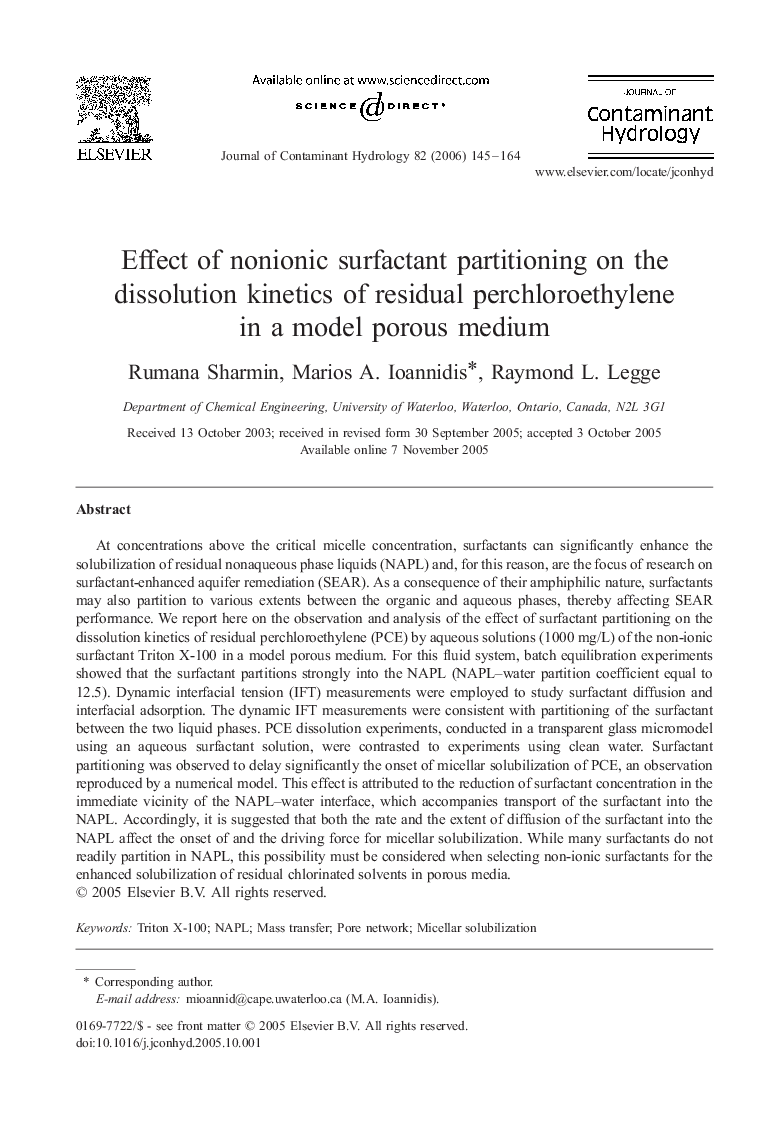| کد مقاله | کد نشریه | سال انتشار | مقاله انگلیسی | نسخه تمام متن |
|---|---|---|---|---|
| 4547789 | 1627143 | 2006 | 20 صفحه PDF | دانلود رایگان |
عنوان انگلیسی مقاله ISI
Effect of nonionic surfactant partitioning on the dissolution kinetics of residual perchloroethylene in a model porous medium
دانلود مقاله + سفارش ترجمه
دانلود مقاله ISI انگلیسی
رایگان برای ایرانیان
کلمات کلیدی
موضوعات مرتبط
مهندسی و علوم پایه
علوم زمین و سیارات
فرآیندهای سطح زمین
پیش نمایش صفحه اول مقاله

چکیده انگلیسی
At concentrations above the critical micelle concentration, surfactants can significantly enhance the solubilization of residual nonaqueous phase liquids (NAPL) and, for this reason, are the focus of research on surfactant-enhanced aquifer remediation (SEAR). As a consequence of their amphiphilic nature, surfactants may also partition to various extents between the organic and aqueous phases, thereby affecting SEAR performance. We report here on the observation and analysis of the effect of surfactant partitioning on the dissolution kinetics of residual perchloroethylene (PCE) by aqueous solutions (1000 mg/L) of the non-ionic surfactant Triton X-100 in a model porous medium. For this fluid system, batch equilibration experiments showed that the surfactant partitions strongly into the NAPL (NAPL-water partition coefficient equal to 12.5). Dynamic interfacial tension (IFT) measurements were employed to study surfactant diffusion and interfacial adsorption. The dynamic IFT measurements were consistent with partitioning of the surfactant between the two liquid phases. PCE dissolution experiments, conducted in a transparent glass micromodel using an aqueous surfactant solution, were contrasted to experiments using clean water. Surfactant partitioning was observed to delay significantly the onset of micellar solubilization of PCE, an observation reproduced by a numerical model. This effect is attributed to the reduction of surfactant concentration in the immediate vicinity of the NAPL-water interface, which accompanies transport of the surfactant into the NAPL. Accordingly, it is suggested that both the rate and the extent of diffusion of the surfactant into the NAPL affect the onset of and the driving force for micellar solubilization. While many surfactants do not readily partition in NAPL, this possibility must be considered when selecting non-ionic surfactants for the enhanced solubilization of residual chlorinated solvents in porous media.
ناشر
Database: Elsevier - ScienceDirect (ساینس دایرکت)
Journal: Journal of Contaminant Hydrology - Volume 82, Issues 1â2, 5 January 2006, Pages 145-164
Journal: Journal of Contaminant Hydrology - Volume 82, Issues 1â2, 5 January 2006, Pages 145-164
نویسندگان
Rumana Sharmin, Marios A. Ioannidis, Raymond L. Legge,